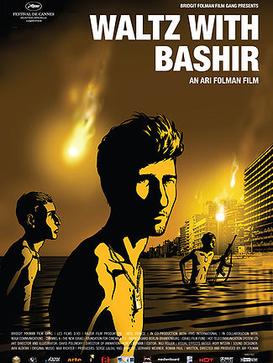Saturday, 7 May 2016
Waltz with Bashir: The Animated Horrors of War.
Waltz with Bashir is a 2008 Israeli animated documentary from director Ari Folman, following the director as he recounts his experiences as a soldier in the 1982 Lebanon war with fellow veterans. The film employs a unique style of digitally produced animation, with the aid of reference video and rigged 2D character models. The director insisted on not using rotoscoping techniques for the animation, instead he videoed actors mimicking out the actions on a soundstage and had the animators use this as reference before animating the same actions on a rigged character model in Adobe Flash.
Personally, while I find the actual animation to be stiff and jarring at times, the illustrative and cinematic style I feel more than makes up for it's shortcomings. The drawing style used in the film reminds of illustrators such as Casey Burns, with emphasis placed on contrast between light and shadow as well as simple, single-colour colour palettes. Linework is detailed and highly figurative, arguably some of the most detailed animated characters in a 2D feature film, which lends weight to the seriousness of the subject matter depicted in the documentary. This seems to have been an aesthetic decision, as visually the film's style fluctuates between gritty realism and surrealist fantasy in order to convey the absurdity and thoughtless barbarism of the war.
At times there is a level of dissonance between the audio and the visuals, a deliberate decision made by the director, such as in a scene where Israeli soldiers shoot a young boy who fired an RPG at them set to a piece of classical orchestral score, lending the scene am unsettling, surreal and almost ethereal tone. The same can be said for the scene from which the film takes it's title, when a soldier crazed in the midst of gunfire runs out into the street in a sort of dance as music plays in the background, to open fire on soldiers with the banner of Lebanese militia leader Bachir Gemayel overlooking the scene.
Waltz with Bashir is a rarity in the medium of animation, a very uncompromising and adult depiction of war and the effects combat has on the soldiers that does not sugarcoat or glorify either side's action, understanding that conflict is never simply black and white and that all sides are equally capable of the same atrocities. Many film makers would either stray away completely from using graphic violence or overuse it to the point it loses all gravitas and sense of reality, but Folman cleverly strikes the right balance, choosing instead to use it to punctuate dramatic scenes, mostly by depicting the aftermath, with the violence itself often occurring offscreen, a technique used it's best in the final scene of the film, where we cut directly from scenes of civilians being marched into a town before cutting to live action footage of the aftermath of a civilian massacre.
Filmmaker Francois Truffaut famously said that 'there is no such thing as an anti-war film' his argument being that films by their very nature can never effectively depict the brutality and thoughtlessness of war as the audience is inherently disconnected, they know that the images they are seeing are not real. Waltz with Bashir in my opinion disproves Truffaut's theory, it's muddied depiction of the memories of war starling precisely because of the simultaneous artificiality, the result of the images on screen being animated and attention to detail in the anecdotes. The film humanises soldiers who commit heinous acts as being caught in the midst of an absurd conflict in which nobody knows why they are there, characterising many as being out of their depth and afraid, mislead by their leaders and blinded by ideology.
In a sense, the aesthetic of the film is a reflection of the memories of war, a subjective representation of our character's suppressed trauma. Like in war, subjects are depicted not as people but as symbols and caricatures of people, our character's feelings towards the environments they are placed in is reflected in the environments themselves. Towns are depicted as ruineous urban mazes, the inside of a tank a dark and claustrophobic coffin filled with corpses, our characters standing on the bodies of their friends, questioning why they're fighting. Waltz with Bashir is one of the most powerful representations of the horrors of war ever put to film, simultaneous brutal and poignant, funny and terrifying and beautiful yet horrific, a true gem of 21st Century animation.
Subscribe to:
Post Comments (Atom)

.jpg)
No comments:
Post a Comment